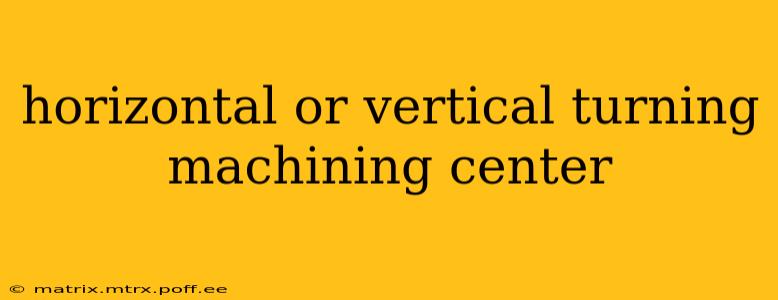Choosing between a horizontal turning center (HTC) and a vertical turning center (VTC) can be a significant decision for any manufacturing operation. Both offer powerful machining capabilities, but their designs cater to different applications and workpiece characteristics. This comprehensive guide will delve into the key differences, helping you determine which machine best suits your specific needs.
What is a Horizontal Turning Center (HTC)?
A horizontal turning center, also known as a horizontal lathe, features a horizontally oriented spindle. Workpieces are typically held in a chuck or collet and rotate horizontally. The cutting tools move along the X, Z, and often Y axes to perform various machining operations. HTCs excel in machining long, slender parts, and are often equipped with tailstocks for added support during operations. Their design allows for better chip management, particularly for long, continuous cuts.
What is a Vertical Turning Center (VTC)?
A vertical turning center, also known as a vertical lathe, features a vertically oriented spindle. Workpieces are typically clamped to the machine table, which rotates horizontally. Tools are positioned above and move along the X and Y axes to perform machining operations. VTCs are ideal for machining large, heavy, and complex parts, often with significant diameter. Their design allows for greater stability and rigidity, making them suitable for heavy-duty operations.
Horizontal vs. Vertical Turning Centers: Key Differences
Here's a table summarizing the key differences:
| Feature | Horizontal Turning Center (HTC) | Vertical Turning Center (VTC) |
|---|---|---|
| Spindle Orientation | Horizontal | Vertical |
| Workpiece Size | Typically long and slender | Typically large diameter, heavy |
| Tool Movement | Primarily X, Z, and sometimes Y axes | Primarily X and Y axes |
| Chip Management | Generally better for long, continuous cuts | Can be more challenging for large chips |
| Machine Rigidity | Can vary depending on size and design | Generally higher rigidity |
| Applications | Shafts, rods, long parts | Large discs, flanges, heavy components |
| Setup Complexity | Can be more complex for larger parts | Can be simpler for large, symmetrical parts |
Which Type is Right for My Needs?
The choice between an HTC and a VTC hinges on several factors:
- Workpiece size and shape: HTCs are better suited for long, slender parts, while VTCs excel with large-diameter components.
- Machining operations: The type of operations required (e.g., facing, turning, boring, drilling) will influence the choice.
- Material: The material being machined (e.g., steel, aluminum, plastics) will impact the required machine power and rigidity.
- Production volume: High-volume production may necessitate a faster, more automated machine.
- Budget: VTCs tend to be more expensive than HTCs due to their size and complexity.
What are the advantages of using a horizontal turning center?
Horizontal turning centers offer several advantages, including:
- Better chip management: The horizontal orientation allows for easier chip removal.
- Suitable for long and slender workpieces: Their design makes them ideal for machining these parts efficiently.
- Often more affordable: Compared to VTCs, they often have a lower initial cost.
What are the advantages of using a vertical turning center?
Vertical turning centers provide the following benefits:
- Greater rigidity: Their design leads to better stability during heavy-duty machining.
- Ideal for large and heavy workpieces: They can handle components that would be difficult or impossible for an HTC.
- Improved accessibility: The vertical arrangement allows for easier access to the workpiece for setup and loading/unloading.
What are the applications of horizontal turning centers?
Horizontal turning centers find applications in various industries, including:
- Automotive: Manufacturing crankshafts, axles, and other engine components.
- Aerospace: Machining long, slender parts for aircraft and spacecraft.
- Energy: Creating components for turbines and other energy-related equipment.
What are the applications of vertical turning centers?
Vertical turning centers are utilized in a wide range of applications:
- Heavy machinery: Manufacturing large components for construction and industrial equipment.
- Power generation: Producing large components for turbines and generators.
- Rail: Creating wheels, axles, and other parts for railway systems.
By carefully considering these factors and the information outlined above, you can make an informed decision about whether a horizontal or vertical turning center is the best investment for your manufacturing facility. Remember to consult with machine tool experts to discuss your specific needs and receive personalized recommendations.
